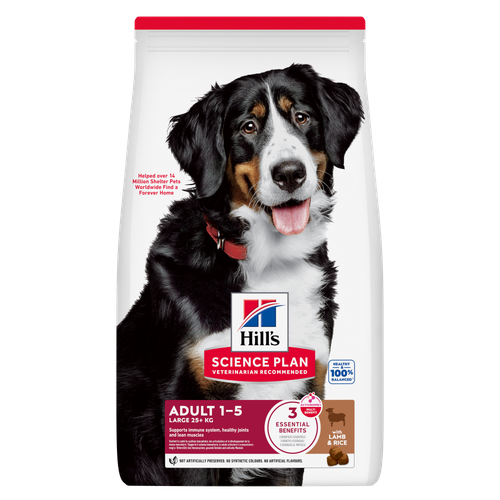
-
Find the right food for your petTake this quiz to see which food may be the best for your furry friend.Find the right food for your petTake this quiz to see which food may be the best for your furry friend.Featured products
 Perfect Digestion Large Breed Puppy Food
Perfect Digestion Large Breed Puppy FoodPrecisely balanced nutrition with Hill's ActivBiome+ prebiotic blend actively contributes to supporting digestive health and overall wellbeing to help your pet feel their best
Shop Now Large Breed Adult Dog Food
Large Breed Adult Dog FoodHill's Science Plan Large Breed Adult Dog Food with Lamb & Rice is a complete pet food, specially formulated with ActivBiome+ Multi-Benefit Technology.
This food is specifically designed to fuel the energy needs of large breed dogs during the prime of their life.Shop Now Adult Light Dog Food
Adult Light Dog FoodHill's Science Plan Light Adult Wet Dog Food is a complete premium pet food for adult dogs that tend to gain weight easily. This deliciously smooth loaf is formulated to deliver the appropriate amount of energy to support weight maintenance in adult dogs.
Shop NowFeatured products CULINARY CREATIONS ADULT CAT FOOD
CULINARY CREATIONS ADULT CAT FOODHill's Science Plan CULINARY CREATIONS Adult cat food with Salmon & Carrots was formulated to provide a great-tasting experience to cats. Its delicious flavour and texture are combine with essential nutrients to support cats' optimal health during the prime time of their life. Specially formulated with high-quality salmon protein, essential taurine for heart health & balanced minerals to support kidneys & bladder.
Shop Now Sterilised Adult Cat Food
Sterilised Adult Cat FoodHill's Science Plan Adult Sterilised Cat Dry Food with Salmon is specially formulated with ActivBiome+ Multi-Benefit Technology. It is a precisely balanced nutrition, tailored to meet the needs of sterilised cats, to help keep sthem lean & healthy.
Shop Now Adult Cat Food
Adult Cat FoodHill's Science Plan Adult Cat Food with Chicken is a complete pet food, specially formulated with ActivBiome+ Multi-Benefit Technology.
This food is specially formulated to fuel the energy needs of cats during the prime of their life.Shop Now -
Dog
- Dog Tips & Articles
-
Health Category
- Weight
- Food & Environmental Sensitivities
- Urinary
- Digestive
- Joint
- Kidney
-
Life Stage
- Puppy Nutrition
- Adult Nutrition
- Senior Nutrition
Cat- Cat Tips & Articles
-
Health Category
- Weight
- Skin & Food Sensitivities
- Urinary
- Digestive
- Kidney
-
Life Stage
- Kitten Nutrition
- Adult Nutrition
Featured articles The Incredible Science Behind Your Pet's Microbiome
The Incredible Science Behind Your Pet's MicrobiomeLearn what your pet's microbiome is, how it contributes to your pet's gut and overall health, and why nutrition is important in maintaining healthy microbiomes.
Read More Microchipping: The Facts | Hill's Pet
Microchipping: The Facts | Hill's PetThe government has announced that as of April 2016, all dogs in the UK must be microchipped by law.
Read More Pet Nutrition: What Makes "Healthy" Pet Food Healthy? | Hill's Pet
Pet Nutrition: What Makes "Healthy" Pet Food Healthy? | Hill's PetIn people, the right diet is very important. If you are eating the wrong way for your metabolism, activity level, age and lifestyle you could end up with health issues.
Read More -


Your dog loves to splash in puddles, but when it's time for a bath, they tuck their tail and hide. Why do dogs hate baths so much? If it's not the water, what is it about getting clean that makes so many dogs shiver and whine? Discover what might be behind your dog's fear of bath time, and keep reading to learn how to wash a dog that hates baths.
Why Do Dogs Hate Baths?
While it's true that not all dogs like to play in water, this doesn't necessarily explain why your dog doesn't like to take baths. Even water-loving breeds like Labrador retrievers often baulk at being bathed. So if it's not about the water, why do dogs hate baths? A number of factors could explain why your dog hates going near the tub or sink.

Recalling Bad Associations
Just like us, dogs can learn to associate a certain situation with feeling scared or anxious, explains the PDSA. A bad experience associated with bathing, like getting scalded by hot water, slipping and falling in the tub, getting water up the nose, or getting stinging shampoo in the eyes, can traumatise your dog and teach them to fear baths. Even upsetting experiences with other grooming activities, like pain caused by getting their nails clipped too short, or having their ears cleaned, can create bad associations with bath time if it happened around the same time.
Loss of Control
When your dog goes swimming or splashes in a puddle, it's a fun activity they choose to participate in. Baths, on the other hand, are typically forced on dogs, and involve being handled and having their bodies moved around in ways they don't like. This loss of choice and control over what happens to them can be very upsetting to a dog.
Unfamiliarity
Dogs who are new to baths, or who aren't bathed as often, may simply be freaked out by the unfamiliar experience of being plunged into a tub of water and soaped up with shampoo. This, in turn, can create negative associations that make them fearful of future baths.
Bath Time Feels Stressful
Sometimes, dogs aren't the only ones who hate their bath times. Dogs often take their emotional cues from their pet parents. The more worried you seem, the more worried your dog is likely to be, says the PDSA. Shouting at your dog, handling them roughly, and hurrying through bath time all teach your dog that baths are something to fear. Even if you're gentle with your dog, they'll be able to sense your frustration, which can be enough to make them dread baths in the future.
Do Dogs Need to Take Baths?
Does your dog actually need regular bathing? It depends. Much of the reason for bathing dogs is simply to make them easier to live with. You don't want your dog tracking mud everywhere, nor do you enjoy cuddling a stinky dog. Short-haired breeds with healthy skin don't actually require bathing for their own benefit, and they don't really need to take regular baths unless they tend to get dirty a lot. In many cases, wiping them down with pet wipes might be all that's needed. However, if you have a wrinkly breed like a pug or shar-pei, you should also be sure to wipe the folds between their skin regularly.
Long-coated and curly-haired breeds, on the other hand, benefit from regular shampoo and conditioning to help keep their fur from matting and becoming unmanageable, although daily brushing can also help. Hairless breeds like the Mexican hairless need regular baths to prevent their skin from drying out. Conversely, dogs with oily skin, like cocker spaniels, also need frequent baths to prevent oil buildup.


Tasty Tips
How to Bathe a Dog Who Hates Baths
If your dog has the type of skin or coat that makes bathing necessary, the best thing you can do is recondition them to enjoy baths, or at least to not be afraid of them. This involves replacing negative associations with positive ones, along with time and patience. How much so depends on whether your dog is terrified of baths, just mopey about having to take them, or somewhere in the middle.
1. Stay Calm
First, make sure you're projecting a positive attitude about giving your dog a bath. If you're feeling rushed, stressed or frustrated with your dog, you should wait to bathe them until a time when you're more relaxed, which will in turn help your dog to feel calmer.
2. Create Positive Associations

Blue Cross recommends introducing your dog to bath time slowly, first by simply bringing them into the bathroom with you, giving them lots of praise, and offering them some treats. Don't attempt to give them a bath right away, but give them time to form positive associations with the bathroom and the tub. One way to turn your dog's fear of the tub into anticipation is by moving your dog's food bowl into the bathroom next to the tub, and leaving a trail of treats leading up to it. When you think your dog is ready, move their bowl into the tub onto a non-slip mat. Allow them to climb in on their own if they're large enough, reinforcing a sense of choice and being in control.
Once your dog is able to be in the bathtub without fear, remove their food and try turning on the water. Give them toys to play with in the tub as well as treats. Blue Cross suggests smearing some xylitol-free peanut butter on the wall and letting them lick it off while the water runs. When your dog is able to tolerate hearing the running water and getting their paws wet, try splashing a bit of water on them, keeping things fun and light and making a game out of it. Gradually work up to wetting them down and lathering them up with shampoo, while at the same time showering them with praise and soothing words. At any stage of this process, if your dog becomes agitated, stop and try again tomorrow.
3. Prevent Negative Associations
Take precautions to make your dog feel safe during bath time. Place a non-skid mat or non-slip stickers in the bottom of the tub to prevent them from slipping, and consider using a bath harness like the ones used by professional groomers to help your dog feel more secure. Take extra care to be gentle with your dog. Be sure to test the temperature of the water and make sure it's not too hot or too cold. Avoid spraying or pouring water directly in their face; instead, use a washcloth on the face and other sensitive areas. And save other dog grooming activities, like trimming nails and brushing teeth, for another day.
While a number of possibilities can answer the question of why dogs hate baths, the solutions are the same regardless of what triggers your pet's dislike. With plenty of patience, gentleness and care, you can turn your dog's attitude toward baths around and make bath time more enjoyable and less stressful for you both.


Jean Marie Bauhaus is a pet parent, pet blogger, and novelist from Tulsa, Oklahoma, where she usually writes under the supervision of a lapful of fur babies.
Related products

Precisely balanced nutrition with Hill's ActivBiome+ prebiotic blend actively contributes to supporting digestive health and overall wellbeing to help your pet feel their best

Hill's Science Plan Adult Wet Dog Food with Turkey is a complete premium pet food for adult dogs from 1 year. This deliciously smooth minced turkey loaf is formulated to deliver the appropriate amount of energy to support the needs of adult dogs.

Hill's Science Plan Large Breed Adult Dog Food with Lamb & Rice is a complete pet food, specially formulated with ActivBiome+ Multi-Benefit Technology.
This food is specifically designed to fuel the energy needs of large breed dogs during the prime of their life.

Hill's Science Plan Light Adult Wet Dog Food is a complete premium pet food for adult dogs that tend to gain weight easily. This deliciously smooth loaf is formulated to deliver the appropriate amount of energy to support weight maintenance in adult dogs.
Related articles
Discover the causes, signs, and treatments of kidney disease in dogs and find methods of supporting your dog's kidney health. Learn more at Hill's Pet.

Gurgling tummies in turmoil are not good news for pets. Owners who have to clean up the unfortunate consequences, digestive problems are one of the rare downsides to owning a pet.

Learn to see the signs of an upset stomach in your dog, understand the triggers and explore some possible solutions.

Dog obesity is a significant problem - learn more about helping your dog become trimmer and healthier through improved nutrition.

Put your dog on a diet without them knowing
Our low calorie formula helps you control your dog's weight. It's packed with high-quality protein for building lean muscles, and made with purposeful ingredients for a flavourful, nutritious meal. Clinically proven antioxidants, Vitamin C+E, help promote a healthy immune system.
Put your dog on a diet without them knowing
Our low calorie formula helps you control your dog's weight. It's packed with high-quality protein for building lean muscles, and made with purposeful ingredients for a flavourful, nutritious meal. Clinically proven antioxidants, Vitamin C+E, help promote a healthy immune system.

